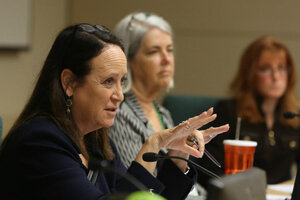California's new water restrictions: If drought lingers, are they enough?
With reservoirs at historic lows, the State Water Resources Control Board imposed new restrictions on both urban and agricultural water use. Such emergency measures may be just the beginning.

Felicia Marcus (l.), chairwoman of the State Water Resources Control Board, questions staff about a proposal to expand restrictions on water use, during a hearing in Sacramento on Tuesday. The board voted to extend the statewide outdoor water limits imposed in July and to impose new rules that require local water departments to restrict the number of days residents can water their lawns.
Rich Pedroncelli/AP
LOS ANGELES
After a NASA scientist declared that California reservoirs would be out of water within the year, policymakers sent an urgent message about the state’s prolonged drought: time to get serious about water, how we use it and where we get it.
The State Water Resources Control Board on Tuesday issued emergency regulations for the entire state. If approved, as expected, these mandatory restrictions take effect in April.
“We are experiencing the lowest snowpack and the driest January in recorded history, and communities around the state are already suffering severely from the prior three years of drought,” said board chair Felicia Marcus in a statement.
“If the drought continues through next winter and we do not conserve more, the consequences could be even more catastrophic than they already are,” she added.
The new measures limit both urban water use, which accounts for 20 percent of the state's overall water use, and agricultural, which accounts for 80 percent. The measures direct restaurants not to serve water unless requested and hotels and motels to offer guests the option to not launder linens daily. All districts must have some restrictions on landscape watering – those without limits will be restricted to two days per week. Car washing is allowed only with hoses equipped with a shutoff valve and sprinklers must be set to avoid watering sidewalks and asphalt.
At the same time, the California Water Resources Board, which administers water deliveries from the State Water Project, has announced that it will severely cut requested deliveries for both agriculture and urban users in 2015.
“They’ve all been cut across the board to 20 percent of what they asked for," says spokesman Nancy Vogel.
But if the drought persists and “we get to the point where water is needed for essential human health, supplies will be made available, even if they need to come from agriculture," she adds.
While dire predictions may have left the impression that faucets will run dry within the year, "that’s just not the case," she says. "We would not let that happen.”
Nonetheless, the state’s reservoirs are at historic lows and groundwater pumping has seriously depleted underground reserves. Without more serious measures, many observers suggest that California’s farmers will be hard hit. Some 400,000 acres have already been left fallow, with 50,000 farm workers out of jobs.
With surface water resources drastically reduced by the drought, farmers have been forced to withdraw more from the ground, notes hydrologist Chris Williams, from Clark University in Worcester, Mass.
“But such heavy reliance on groundwater is highly unsustainable,” he says.
Given the worsening drought, California needs to seriously consider quick action to impose mandatory water-use restrictions across all sectors to ration remaining water resources as well as to closely monitor and regulate groundwater withdrawals, he says.
The need is critical, says Professor Williams. “There is no relief in sight.”
A recent Field poll shows that some 94 percent of Californians understand that the drought is serious. But historical records show the real threat of "megadrought," and climate change projections signal a risk of more frequent severe hot and dry conditions in the coming century. He says both the state of California and its residents need to prepare much more comprehensive drought management plans and strategies for rationing dwindling water resources.
In fact, the emergency mandatory measures are just the beginning, says Control Board spokesman Max Gomberg, noting that they are only in place for 270 days. After that, he says, “we will continue to try every tool in our toolbox,” including reusing so-called grey water and switching irrigation systems from spray systems to drip.
As for water rations, Mr. Gomberg says that usage decisions are made at the local level and there is a vast patchwork of conservation measures already in place across the state. While he is aware that critics are suggesting a total ban on outdoor watering, he cautions that changes must be made carefully.
When Texas banned outdoor watering during its recent drought, “the state lost 5 million trees,” he says. “This is not a result we would like to have in California.”
An integrated approach to resource management is crucial, agrees Stephen Mulkey, president of Unity College in Maine, a liberal arts college that has devoted its curriculum to sustainability science.
“California has several options and it needs to act now,” he says. The state has missed its opportunity for “proactive adaptation." Reactive adaptation is typically far more disruptive and expensive, he adds.
“We all lose if everyone tries to keep what is theirs now," he says.

